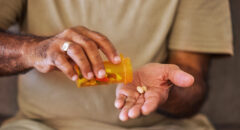
Sexually transmitted diseases (STDs) can be a cause for concern, especially when symptoms are hard to recognize. While some people experience symptoms of an infection, like discharge, burning, or itching in the genital area, other people can have a sexually transmitted infection and have no symptoms at all.
For example, 75 percent of women and 50 percent of men with chlamydia have no symptoms. And, on average, people with HIV don’t develop symptoms for 10 years.
Here are three signs you may have an STD, but not know it:
-
Withdrawal from Sexual Activity
Less sex may mean you may have an STD. We all have times when we may not feel like engaging in sex or sexual activity, even with a partner we love. When your partner suddenly deviates from your relationship’s typical sexual pattern or withdraws from sex completely, however, it could be a sign to watch out for.
This may indicate your partner is trying to hide symptoms from you. Some STD symptoms, including several associated with gonorrhea or chlamydia, are visible in the genital area, so withdrawing from sex could be an attempt to prevent you from seeing these symptoms firsthand.
It could also be that your partner is trying to protect you from transmission, but hasn’t summoned up the courage to tell you about their STD.
Lastly, your partner might be feeling guilty about being in a sexual relationship with someone else. In this case, even if they don’t know whether they’ve contracted an STD, they’re still placing you at risk by engaging in sexual activity with multiple partners.
If you find yourself in this situation, it’s important to talk openly with your partner. Ask for an explanation, but be compassionate. Remember, their withdrawal from sexual activity might be completely innocent, stemming from anxiety, emotional distress or another cause. Regardless of your partner’s answer, however, it might be wise to get an STD test, just in case they’re not being completely honest with you.
-
Mixture of Cold Symptoms
Another sign you may have an STD and not know it is because of the multitude of symptoms. Many STD symptoms are related to
dozens of illnesses, so people infected may not know they have the virus. For example, the first stage of HIV is called an acute HIV infection, which can cause flu-like symptoms within 2 to 4 weeks of infection. Common STD symptoms include:
- Chills
- Fever
- Rash
- Sore throat
- Fatigue
Doesn't that sound like a regular case of the flu? Or a bad cold that's "going around"?
When HIV reaches its second stage—the stage known as an asymptomatic HIV infection, chronic HIV infection, or clinical latency—it continues to multiply within the body without showing symptoms. For some, this dormant stage can last for more than ten years.
-
Physical Changes All Over Your Body
We all know that your body changes as we age, but here are changes to be more concerned about. Not all STDs have noticeable symptoms, but these are the most common signs.
- Sores or bumps. STDs like genital herpes, syphilis, and chancroid can cause sores or bumps on the genital area, anus, or mouth.
- Discharge. An unusual discharge from the penis or vagina can signify chlamydia, gonorrhea, or trichomoniasis.
- Burning during urination. Pain and burning when you urinate are common symptoms of chlamydia, gonorrhea, trichomoniasis, and genital herpes.
- Rashes or itching. Some STDs, like pubic lice and scabies, cause rashes or itching in the genital area.
- Painful sexual intercourse. STDs such as genital warts, pelvic inflammatory disease (PID), and some types of herpes can cause pain during sex.
It is important to note that other conditions can cause these symptoms as well.
The only way to know for sure if you have an STD is to get tested. Walk into your neighborhood CityMD to see a provider or speak with a health care professional during a virtual care appointment.
5 STDs with NO Symptoms You Should Be Aware Of
1. Chlamydia
Chlamydia is one of the most common STIs in women under 25 and is known as a “silent” infection, since most people never experience symptoms. Symptoms of chlamydia include abnormal vaginal discharge or a burning sensation during urination several weeks after sex with an infected partner. It can be easy to confuse these symptoms with something like a yeast infection, so it’s important to see your ob/gyn if you notice changes in discharge, pain or burnin. But, again, it could have no symptoms at all.
If chlamydia goes untreated, it can spread to the uterus and fallopian tubes, resulting in pelvic inflammatory disease. Pelvic inflammatory disease can cause scarring in the fallopian tubes, which can lead to permanent damage that causes infertility. Scarring can also cause an ectopic pregnancy, which can be life-threatening for both mom and baby.
The CDC recommends annual chlamydia screenings for women under 25, pregnant women, or anyone with a new sexual partner (or if you’re not sure of your partner’s STI status). If found early, chlamydia can be treated with antibiotics.
2. Gonorrhea
Similar to chlamydia, gonorrhea is most common in sexually active women under 25 and the majority will never experience symptoms. While the two are different infections, chlamydia and gonorrhea are commonly diagnosed together. Mild symptoms for both are similar (if they ever show up).
Gonorrhea is an infection caused by the bacteria Neisseria gonorrhoeae. More than 550,000 cases were reported to the CDC last year, making it the second most common sexually transmitted infection in the United States.
Most women with gonorrhea don’t have any symptoms, according to the CDC. Leaving gonorrhea untreated can lead to pelvic inflammatory disease, scar tissue that blocks the fallopian tubes, difficulty getting pregnant, and chronic abdominal pain. Pregnant women can also transmit the infection to their baby during delivery, which can cause serious problems in an infant.
Gonorrhea is getting harder to treat because it’s becoming resistant to antibiotics. Current treatment for the disease is to give a one-time injection of the antibiotic Ceftriaxone in addition to oral antibiotics.
If gonorrhea goes untreated, it can lead to pelvic inflammatory disease, scarring and damage to reproductive organs. Your risk of getting HIV is higher, as is your chance of getting life-threatening infections in other parts of your body. Gonorrhea during pregnancy can cause premature birth, miscarriage, low birth weight and serious health complications for newborns.
The CDC recommends an annual gonorrhea screening for women under 25, pregnant women, or anyone with a new sexual partner (or if you’re not sure of your partner’s STI status). Like chlamydia, gonorrhea can be treated with antibiotics.
3. Herpes
Herpes is a viral infection that can present on your mouth or genitals. According to the CDC, one out of every six people between 14 and 49 years old in the U.S. has genital herpes. While most people think of herpes as painful, red blisters, not everyone gets those. While herpes is most infectious during an active breakout, it can still be spread when no symptoms are present.
The best way to reduce your risk of herpes is to use barrier methods (like condoms, dental dams) correctly every time you have sex. While there’s no cure for herpes, there is treatment to manage the symptoms. If you believe you’ve been exposed to herpes, talk to your doctor so they can do a swab test of symptoms or a blood test. If you have it, your doctor will...prescribe medication to manage symptoms and talk with you about reducing the risk of transmission to sexual partners.
4. HIV
HIV sometimes presents with flu-like symptoms about a month after transmission, but otherwise can go undetected for weeks, months, or years.
According to the Mayo Clinic, when a person has contracted the virus and doesn’t receive antiretroviral treatment, it takes a decade on average to turn into AIDS. However, HIV still causes immunodeficiency that can raise the risk of infection and cancer. “Treatment is strongly advised regardless of whether people have symptoms of HIV, as they can have a normal lifespan if they are on treatment and suppress the HIV virus,” Dr. Connie Celum, M.D., MPH, Professor of Global Health & Medicine at UW Medicine, tells Woman's Day.
For those who are higher risk of getting HIV, an HIV prevention option called PrEP (pre-exposure prophylaxis) is also available, and reduces HIV infection rates by 90 percent, Dr. Celum says.
5. Trichomoniasis
This STI is pretty common and caused by a parasite. According to the CDC, an estimated 3.7 million people have trichomoniasis, but only about 30 percent of people with this STI show symptoms. When symptoms present, they can include: itching, burning, redness, soreness, uncomfortable urination, and vaginal discharge that’s different and comes with a fishy odor. For men, the symptoms could include: itching and irritation, a burning sensation after peeing or ejaculating, and a discharge from the penis. These symptoms can come within five to 28 days of being infected.
If left untreated, trichomoniasis can increase your risk of acquiring other STIs, including HIV. If you’re pregnant, trichomoniasis can cause babies to be born preterm or with a low birth weight.
Using condoms every time you have sex lowers your risk of getting trichomoniasis, but it’s possible to be infected even if you practice safe sex. Routine trichomoniasis screening isn’t recommended for everyone, but the CDC does recommend screening in certain high-risk areas of the country and in people with a high risk of infection. Trichomoniasis can be cured with antibiotics, but it’s possible to get infected multiple times.
What to do:
All this information can be scary, but the only way to tell if you or your sexual partner has an STI is to be tested.
Before starting a new sexual relationship both you and your partner should be tested for the most common STIs.
If you aren’t comfortable having your regular doctor examine you, testing can also be done at a family planning or STI clinic. Many clinics even have free, or highly subsidized, tests for people with limited incomes.
But even if your tests come back negative, the best way to keep them that way is to consistently practice safer sex. After all, it can take a while for STI tests to be accurate. In addition, sometimes people have multiple sexual partners, which means there are multiple potential routes for exposure.






